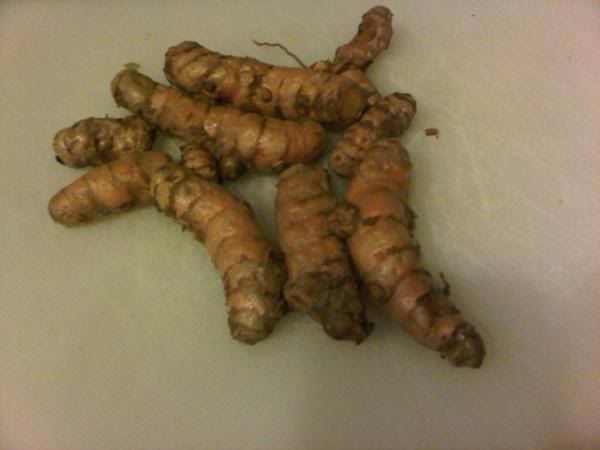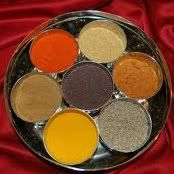Recently my friend Susanna bought fresh turmeric and texted me soon after cutting it up exclaiming ‘My hands are all yellowwwww!!’.

Known as Indian Saffron, Turmeric is a plant native to south Asia and came to the West by way of the marauding Dutch, British and Portuguese who sailed back and forth to Europe. The explorers knew saffron as it was a common ingredient in Arab and southern European rice dishes and associated it to turmeric when they found it in southern India. Southern India is still the largest exporter of turmeric in the world.
Taste-wise it is subtle and not as strong and distinctive as saffron but it does the color well. So it can be easily substituted for saffron if you’re making a paella or a risotto Milanese and is way less expensive than the golden saffron stamens.
The word ‘turmeric’ is often misspelled as ‘tumeric’. Both spellings are accepted but I’d suggest to remember the R! Although I initially thought the word might be of Arabic origin, it’s actually from Middle Latin. Middle Latin? Indeed, after the collapse of the Roman Empire, Latin still remained the language of the Church and scholars.
When something new was found, they needed to name it. That’s what happened with turmeric.
Crusaders invading the Holy Lands found all sort of new items that needed names in Latin. They named it ‘terra merita’ meaning ‘worthy earth’. Slightly odd, it is still unclear where this name comes from. Then as with many other words, the Latin word morphed as it was incorporated into other languages. Terra merita, turned into ‘turmeryte’ in Middle English and then to present day English as Turmeric.
So back to my friend Susanna. She texted me a photo of her fresh turmeric and wow does it look like ginger or what? Indeed, it is related to ginger and belongs to the family of rhizomatous plants. Another cool word, rhizome comes from Greek and means ‘mass of roots’. The roots of the ginger and turmeric plant are clumps of intertwined roots.
Nowadays, you can find turmeric added to many foods mostly for coloring and of course it is still a key ingredients in Indian ‘masalas’. Masala refers to a mixture of spices or rubs that are very popular South Asian food.
Bottom line with turmeric, if you don’t want yellow hands, wear gloves!

Robert Aiudi, a.k.a., The Language Chef, has been known to his friends and family as a “language junkie” nearly his entire life. He is fluent in many, conversational in others and can fake it through another large amount of some of the most exotic languages in the world. He has taught and tutored many happy students, and annoyed people over the years by asking “how do you say that?”.
From his young years surrounded by speakers of three different dialects of Italian, to university in France and German and extensive work in Asia, China, Taiwan, Japan, Robert has picked up languages and breathed in the cuisines of many countries. Translating from 27 languages into English, Robert is a repository of anecdotal and factual information about languages of all sorts which adds flavor and depth to the Language Chef.
An expert amateur cook, Robert has worked in Paris in small bistro, made pizzas in Florence, wrangled recipes out of the hands of German grandmothers in the Black Forest, worked in a Chinese restaurant and had ad hoc cooking lessons in restaurants in China, Taiwan and Japan as well as various Chinatowns. Most importantly, Robert, his mom and dad, two grandmothers and lots of aunts from Italy have made culinary magic in their kitchens for generations.
 Known as Indian Saffron, Turmeric is a plant native to south Asia and came to the West by way of the marauding Dutch, British and Portuguese who sailed back and forth to Europe. The explorers knew saffron as it was a common ingredient in Arab and southern European rice dishes and associated it to turmeric when they found it in southern India. Southern India is still the largest exporter of turmeric in the world.
Known as Indian Saffron, Turmeric is a plant native to south Asia and came to the West by way of the marauding Dutch, British and Portuguese who sailed back and forth to Europe. The explorers knew saffron as it was a common ingredient in Arab and southern European rice dishes and associated it to turmeric when they found it in southern India. Southern India is still the largest exporter of turmeric in the world.










